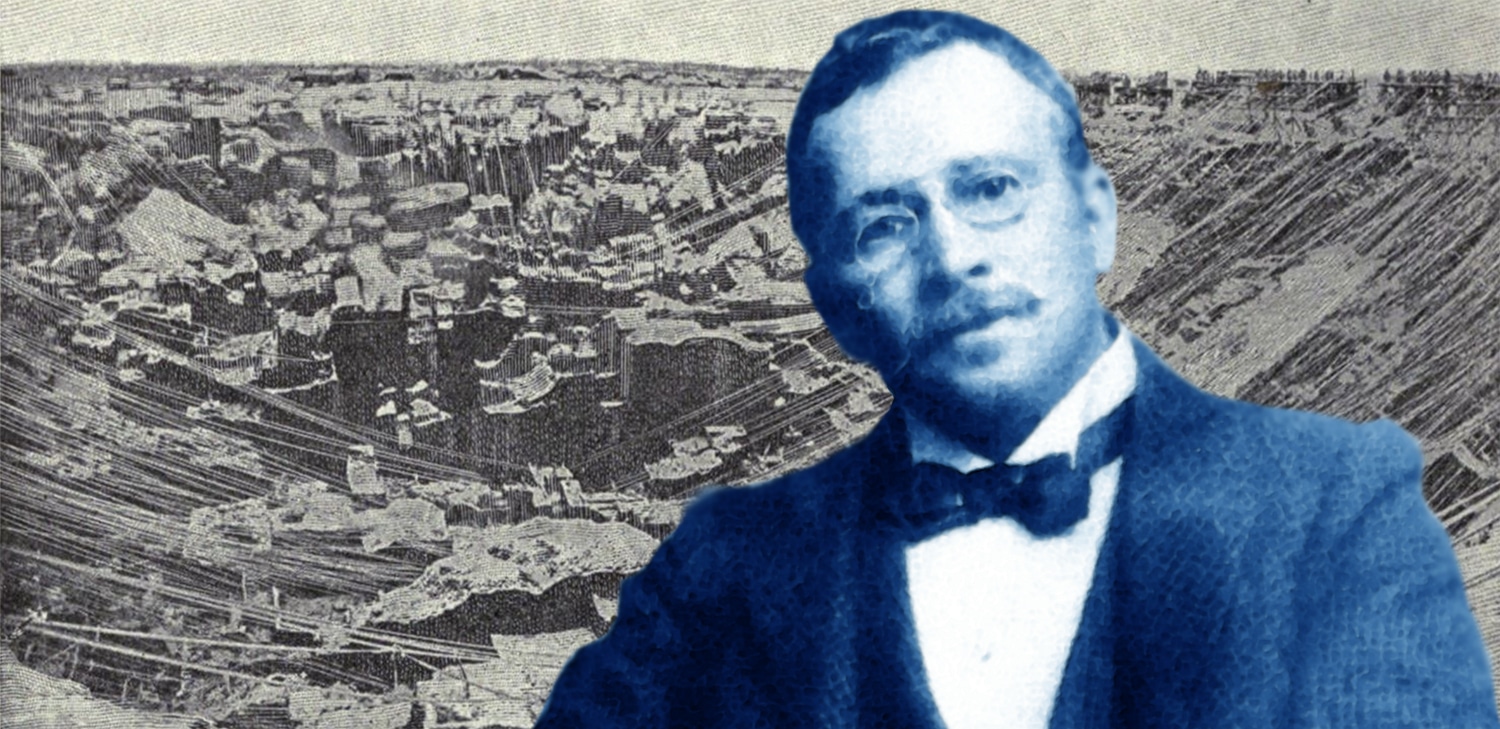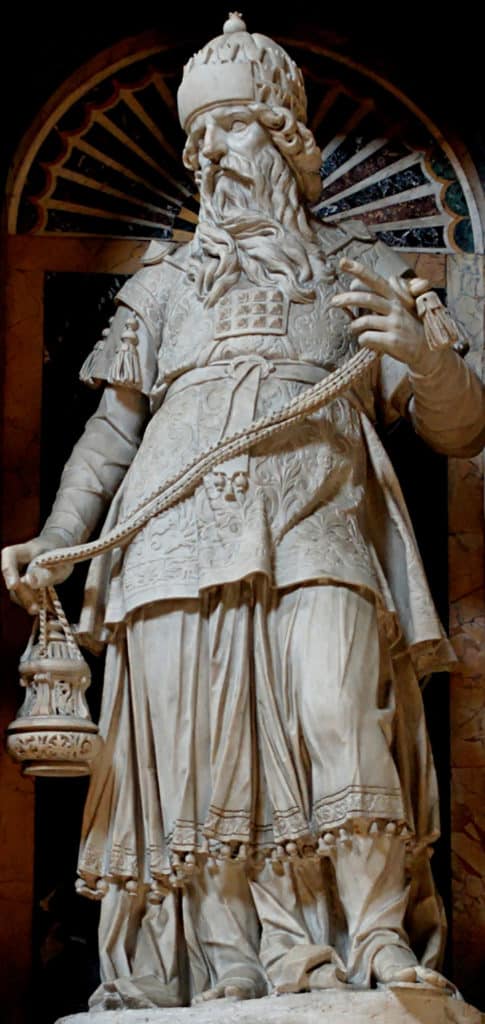Blog
Home » Diamonds blog » THE CONNECTION OF THE JEWISH PEOPLE AND DIAMONDS: FROM THE HIGH PRIEST’S BREASTPLATE TO RAMAT GAN
Focus on

Barney Barnato, the Jewish immigrant from the East End of London, who founded the De Beers with Cecil John Rhodes, seen against the backdrop of the Kimberley Mine in the 1860s.
On Sunday evening, September 25, and for the following three weeks, activity in many of the world’s diamond centers will slow considerably. This is not because of any because of any falloff in demand, nor a result of economic difficulty. It is phenomenon that occurs annually, and is a result of the Jewish New Year, called Rosh Hashanah, and a string of Jewish Holy Days and festivals, among them Yom Kippur, or the Day of Atonement, and Succoth, or the Feast of Tabernacles.
Before the influx of Indian manufacturers and traders, starting in the 1970s, the diamond business was considered to a predominantly Jewish one. And even today, large percentage of its participants are Jewish, although the sector is increasingly multicultural and diverse. The Jewish influence in its norms and practices is also pronounced, right down to the traditional way of sealing a deal, through the utterance of the Hebrew words “Mazal u’ brachah,” which means luck and a blessing in English, or, as is more often is the case, by simply saying “Mazal.”
It has been claimed that the Jewish connection to diamonds stretches back thousands of years. Chapter 28 of the book of Exodus provides exact instructions for the creation of a bejeweled breastplate worn by the high priest of the Children of Israel. Including 12 gemstones, set in four rows one directly above the other, the second row required a “nofeh” or carbuncle, a “sapir,” or sapphire, and a “Yahalom,” which is the Hebrew word for diamond used to this very day.
But there is no archeological evidence for the existence diamonds in the region during the times of the pharaohs, when the exodus of the Jews from Egypt is believed to have taken place.
Gemstone cutters were said to use an instrument called the “shamir,” in Hebrew, which employed a harder gemstone to cut into stones that were softer than it. It is mentioned in chapter 17 of the book of Jeremiah, where there is reference to “a pen of iron with a point of “shamir,” which most often is translated as a diamond. Israeli gemologist Menahem Sevdermish, who has written extensively on the biblical references, has suggested that is more likely that the stone used was corundum, which is known to have been present at the time in Egypt, the Sinai Peninsula and the Levant. But when the prophet Jeremiah was alive, most probably between 650 BCE and 570 BCE, the trade routes to India existed, so it is possible that diamonds had made their way the Land of Israel.
DIAMOND TRADERS BY NECCESSITY
The involvement of Jews in the diamond industry and trade became prominent in the late Middle Ages and Renaissance period, and had less to with any innate talent, and more to do with the predicament in which they existed.
Living in exile and dependent on the whims of the rulers of the regions in which they resided, periodically being subject to expulsion, persecution and sometimes deliberate annihilation, the Jews were generally restricted from buying land and property, or engaging in agriculture or joining the artisan professions controlled by guilds. Goldsmithing, silversmithing and gem cutting were among the few crafts often open to them, and these professions had the added advantage of being mobile, allowing people to pack up quickly and leave, as was often necessary.
Such was the case in Amsterdam toward the end of the 16th Century, when Sephardi-Jewish diamond traders arrived on the run from Spanish forces, bringing with them a diamond industry.
By the 18th Century diamonds were increasingly a Jewish trade in Holland and Belgium, especially with the arrival of Ashkenazi-Jewish immigrants from Central and Eastern Europe.
By the beginning of the 20th Century, almost half of Amsterdam’s Jewish population, which numbered about 50,0000 in the 1890s, was associated with the diamond trade. Jews were also among the founders of the diamond center in New York, which became the gateway to the world’s largest ever diamond market.
DE BEERS AND THE SYNDICATE
When diamonds were discovered in Kimberley, South Africa in the 1860s, Jewish immigrants from Great Britain and Europe were among the thousands who arrived in the area to seek their fortune. Among them was Barney Barnato, from London’s Jewish East End, who together with Alfred Beit, a German Jewish financier and very British Cecil John Rhodes, merged four Kimberley mines together in 1888 to create the De Beers conglomerate.
To release the goods onto the market, without flooding it, the owners of De Beers relied on a group of mainly Jewish traders in London, known as the Syndicate.
One of the merchants was Anton Dünkelsbühler, who had been born in Germany but had moved to London. In 1896 he hired as an apprentice a fellow Jewish German immigrant by the name of Ernest Oppenheimer, who would later travel to Kimberley to represent the firm. In time, Oppenheimer would come to control De Beers, and his family would continue to do for another two generations.

Aaron, the brother of Moses, wearing the breastplate of the high priest of Israel, in a statue by Nicolas Cordier, which can be seen at the Chapel of the Basilica di Santa Maria Maggiore in Rome, Italy.
The establishment of a diamond center in Ramat Gan, Israel, was another chapter in the long Jewish connection to the trade. Founded in the 1930 by immigrants from Amsterdam and Antwerp, it grew in importance during World War II, when the German persecution of the Jews in Holland and Belgium largely shut down diamond production in Europe.
After the war and the establishment of the State of Israel in 1948, thousands of survivors of the Nazi holocaust moved to the country, and served as mentors to a new generation of Jewish diamantaires. The gleaming high-rise diamond center of Ramat Gan, which dominates the eastern skyline of Tel Aviv is testament to the continuing involvement of Jews in the diamond business.

The skyline of the Israeli diamond center in Ramat Gan, Israel, a testament to the continuing Jewish presence in the diamond industry.
